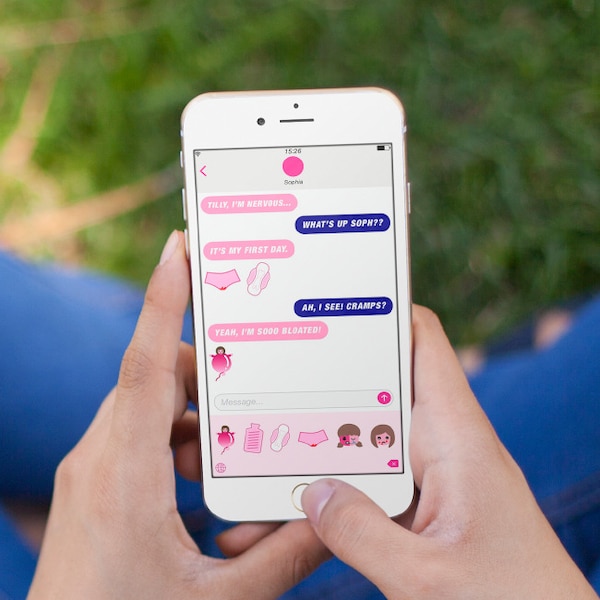
Period Emojis: breaking down period taboos
For two billion women and girls worldwide, periods are a monthly reality. And yet, talking about them is still very much taboo.
The lengths that people will go to, just to avoid using the word ‘period’, is testament to society’s awkwardness towards what is, after all, a perfectly natural bit of blood. How often do you hear women – and men – use an indirect turn of phrase to refer to menstruation?
Each country has its own slang words and euphemisms. In the UK, it’s common to allude to a period as ‘The Curse’. In Sweden, periods are often referred to as ‘Lingonveckan’ (lingonberry week). In France, the bizarre ‘Les Anglais ont débarqué’ (the English have landed). And in Finland, the derogatory ‘hullun lehmän tauti’ (mad cow disease).
Women hide sanitary pads and tampons at home and disguise them in discreet holders when they’re out and about. And all because they don’t want anyone to know they’re menstruating. Yet, no one is embarrassed about the equally normal and natural human need to go to the loo. You don’t see people stashing toilet paper out of sight.
The lengths that people will go to, just to avoid using the word ‘period’, is testament to society’s awkwardness towards what is, after all, a perfectly natural bit of blood.
So just why are periods such a taboo? It could be that, historically, they have been wildly misunderstood and strangely feared – resulting in some pretty crazy myths. The Roman naturalist Pliny the Elder wrote that period blood had the power to spoil food and drink, kill crops, dim mirrors, rust metal and drive away hailstorms. And even as recently as 1878, the British Medical Journal (BMJ) printed comments from physicians who were convinced that if menstruating women touched meat, it could turn rancid.
Incredibly, this myth that a woman on her period is impure still pervades some cultures. In Uganda, for instance, menstruating women are considered to be dirty and contaminated. And menstruation continues to be highly vilified in many countries around the world.
Even in the West, there’s still a stigma around discussing menstruation, especially with boys and men. A 1983 American study [1] revealed that nearly all girls in the United States believed they shouldn’t talk about menstruation with boys. And more than a third thought it was inappropriate to discuss it with their fathers. Just over three decades later, and women are still embarrassed to talk about it.
So how can Bodyform join the quest to break down these taboos and get women talking? Well, if there’s one group that could be the bright light in instigating progress, it’s young women. Historically, female teenagers have proven themselves to be “language disruptors” — innovators who invent new words that make their way into the everyday.
If they are innovators in language, surely they can be innovators in bringing about change too? Could Bodyform encourage more communication about periods by giving young females the tools to talk about them openly and honestly? How about getting young women to share their experiences through the fastest-growing language in the world? The universal language of emoji. [2]
For Generation Z – i.e., young people born from the mid-90s onwards, who grew up in a digitally connected world, the ability to communicate with brevity – texting, Snapchat, emoji, etc – comes naturally.
Long-form typing can seem like too much effort, but a picture message can convey what you feel in seconds. So people increasingly communicate with just one symbol to convey emotion – a heart, a wink, a smile. The emoji has become so pervasive in youth culture, in fact, that Oxford University Press declared in 2015 that the ‘Face with Tears of Joy’ emoji was its ‘Word of the Year’.
Did you know?
But when Bodyform searched the official Unicode emoji keyboard, it found that women, never mind periods, were largely unrepresented. There were only stereotypes like a bride in a veil and a flamenco dancer in a red dress. It just wasn’t diverse enough.
Up until now, there also hasn’t been an emoji for ‘periods’, so women have had to use existing ones inventively, resorting to the ANGRY FACE emoji or even the ERUPTING VOLCANO emoji. Bodyform is so serious about bringing about change, that it has launched a Change.org petition to get six new ‘Femojis’ included in Unicode’s next emoji keyboard update. These six period-themed emoji have been created so that women and girls can talk specifically about menstruation. The Femojis cover the entire menstrual experience, from pads to spotted pants and cramps. These tongue-in-cheek icons will enable girls to express their feelings in a way that comes naturally to them.
With nearly two billion smartphone users around the world, communicating about menstruation via the medium of Femojis makes complete sense. “Menstruation is a natural process, but we still live in a society where we hide pads up our sleeves, where images of blood stains are removed from social media, and British sportswomen are reluctant to speak up on the impact of menstruation on their performance,” says UK marketing director Nicola Coronado. “In short, menstruation is still a taboo (in the UK). We want to break this taboo by generating more conversation around this potentially uncomfortable subject matter.”
To date, Bodyform’s Change.org petition has received nearly 37,000 signatures. With continued hard work, it hopefully won’t be long before female emoji are part of our universal language. If we start talking about periods in more positive ways, instead of only talking about the downsides, then it’s much more likely they will eventually become an everyday topic of conversation. Because something that happens to half of the world’s population every month shouldn’t be taboo.
To sign Bodyform’s Femojis petition, visit: www.change.org/p/femojis-uk
[1] Beliefs and attitudes of young girls regarding menstruation (L R Williams, 1983)
[2] www.bbc.co.uk/newsbeat/article/32793732/uks-fastest-growing-language-is-emoji
